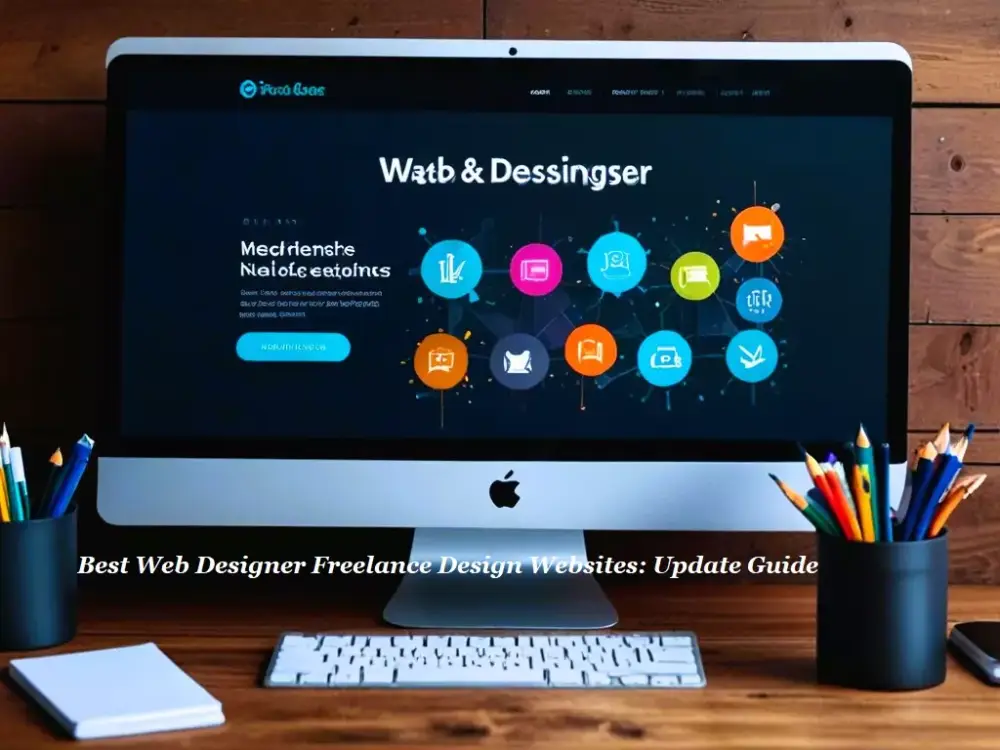In today's digital landscape, the demand for skilled web designers is at an all-time high. That's why I'm here to help guide you on the best web designer freelance design websites.
As businesses increasingly recognize the importance of a strong online presence, freelance web designers have a unique opportunity to capitalize on this trend.
This guide explores the best web designer freelance design websites where designers can find quality work opportunities, enhance their visibility, and connect with potential clients.
In the ever-evolving landscape of freelance work, web designers have a wealth of opportunities at their fingertips.
With the rise of remote work and digital platforms, finding the right freelance design website can make all the difference in securing quality projects and building a successful career.
This comprehensive guide explores the best web designer freelance design websites, highlighting their unique features, advantages, and potential drawbacks.
By understanding these platforms, you can effectively navigate the freelance marketplace and enhance your visibility as a designer.
Freelance Landscape Overview: Opportunities and Growth
In today’s digital era, the demand for skilled website designers has surged, fueling the growth of freelancing in the web design industry.
As companies transition to online platforms, website designers are now essential to crafting engaging, responsive, and aesthetically pleasing digital experiences.
This demand was further propelled by the pandemic, which caused a sharp rise in freelancing.
Currently, there are over 1.57 billion freelancers worldwide, with 73 million in the USA alone—a number expected to hit 90.1 million by 2028.
This shift from traditional employment is significant, with 71% of U.S. employees projected to engage in freelancing by 2024.
As the freelance landscape expands, website designers can explore a wealth of opportunities across various freelance platforms, offering them flexibility, independence, and access to a global client base.
This guide will assist both aspiring and established web designers in identifying the best freelance platforms to showcase their skills and connect with potential clients in the competitive market.
Benefits of Freelancing for Website Designers
Before diving into the best web designer freelance websites, it’s important to highlight the key benefits of freelancing for web designers:
-
Flexibility and Work-Life Balance: Freelancers enjoy the freedom to work from any location, managing their schedules and achieving a healthier work-life balance.
-
Diverse Client Exposure: Freelancing allows designers to collaborate with clients from various industries, enriching their experience and helping them develop a broader design perspective.
-
Skill Development and Portfolio Building: By working on a wide range of projects, designers can continuously improve their skills and build a more comprehensive portfolio, showcasing their versatility.
-
Higher Earning Potential: Freelancers can set their rates and scale their income based on their experience and the value they bring to clients.
Choosing the Right & Best Web Designer Freelance Websites Platforms
When selecting the best freelance websites for web designers, consider these critical factors to maximize your success:
-
Reputation and Trustworthiness: Choose platforms with strong reputations and positive user reviews to ensure a reliable work environment.
-
Project Types and Niche Focus: Select websites that align with your skills and offer relevant projects to your expertise.
-
Fee Structures and Payment Methods: Analyze the platform’s fee structure and payment options to ensure they meet your financial goals.
-
Client and Designer Support: Look for platforms that offer robust customer support to assist both clients and designers during the project.
Building a Strong Online Presence
Before exploring the top freelance websites for web designers, it’s crucial to focus on building a powerful online presence.
Establishing a strong online footprint directly impacts your ability to attract clients and position yourself as a skilled freelance web designer.
Here are five key strategies to boost your visibility:
-
Create a Professional Portfolio Website: Showcase your best work, skills, and client testimonials. Ensure the site is optimized for search engines to attract organic traffic and improve visibility.
-
Develop an Active Social Media Presence: Engage on platforms like Instagram, Twitter, and Behance, sharing your design projects and industry insights to connect with potential clients.
-
Content Marketing Strategy: Write blogs, tutorials, or case studies related to web design. This helps position you as an expert in your niche, attracting inbound leads through valuable content.
-
Networking and Collaboration: Attend industry events, webinars, and forums. Collaborating with other freelancers or agencies can open new opportunities and expand your network.
-
Client Testimonials and Reviews: Display positive feedback from satisfied clients prominently on your website. This builds trust and credibility with prospective clients.
Top 15 Freelance Websites for Web Designers in Brief
Now that you understand the importance of a strong online presence and the growing opportunities in the freelance market, let’s explore the best web designer freelance websites available today:
-
Upwork – One of the largest freelance platforms, offering projects across various categories, including web design.
-
Fiverr – Ideal for offering specific web design services at different price points, perfect for new freelancers.
-
Legiit – A growing freelance platform focused on digital services, offering opportunities in web design, SEO, and marketing with a strong emphasis on quality and client satisfaction.
-
Sohojware - A specialized digital services company offering comprehensive digital marketing, website design & developments, mobile application development for Android and iOS platforms.
-
Freelancer – A well-established platform with a variety of projects for web designers, from small gigs to large-scale contracts.
-
Toptal – A premium platform that connects the top 3% of freelance designers with high-quality clients.
-
PeoplePerHour – Connects freelancers with businesses looking for quick-turnaround projects.
-
We Work Remotely – A great platform for finding remote, long-term freelance opportunities.
-
Dribbble – Primarily known as a portfolio site, Dribbble also offers a jobs section dedicated to freelance designers.
-
Guru – Provides a wide range of freelance opportunities with a solid project management interface for freelancers.
-
Behance – A vibrant platform that allows creative professionals to showcase their portfolios, connect with peers, and discover job opportunities in web design and other creative fields.
-
FlexJobs – Specializing in remote and flexible job opportunities, FlexJobs curates listings for freelance web design projects, ensuring quality and legitimacy for freelancers seeking work-life balance.
-
Working Not Working – A curated platform for top creative talent, Working Not Working connects freelance web designers with high-profile clients and agencies looking for exceptional design expertise.
-
DesignCrowd – A unique platform that enables designers to participate in design contests, allowing them to showcase their skills and win projects while connecting with clients seeking custom web design solutions.
-
Coroflot – A creative job board specifically for designers, Coroflot features freelance web design opportunities alongside salary insights and a portfolio showcase, helping designers find the right fit for their skills.
These platforms offer a variety of opportunities, helping freelance web designers find the right fit for their skills and preferences.To maximize your success, it's crucial to choose the right websites that align with your skills and career goals.
Below, we delve into some of the top platforms for freelance web designers, highlighting their unique features and benefits.
1. Upwork
As one of the largest freelance marketplaces globally, Upwork offers a diverse range of job postings for web designers. From small startups to large corporations, clients from all sectors utilize Upwork to find freelancers.
Pros:
-
A vast array of job opportunities across various design specialties
-
Flexible bidding system allows freelancers to set their rates
-
Built-in project management tools streamline communication and workflow
Cons:
-
New freelancers may struggle to secure jobs due to competition and client reviews
-
Fees can be high, especially for low-budget projects
Tip: Create a compelling profile that highlights your skills and previous work. Consider starting with lower rates to build your reputation and gather positive reviews.
2. Fiverr
Fiverr operates on a gig-based model where freelancers can offer specific services at set prices. It’s particularly useful for web designers who specialize in niche areas or specific tasks within web design projects.
Pros:
-
User-friendly interface allows clients to browse easily through services offered by freelancers.
-
Flexibility in pricing enables designers to create packages tailored to different client needs.
Cons:
-
Competitive environment can drive prices down, making it challenging for new freelancers to earn higher rates initially.
Tip: Develop unique service packages that highlight what sets you apart from other designers on the platform, such as quick delivery times or specialized skills.
3. Legiit
Legiit is an emerging platform that allows freelancers to offer digital services like web design, SEO, and marketing through customizable service listings.
It's ideal for web designers who want to showcase their expertise and deliver specialized projects.
Pros:
-
Focus on quality service, with a community that emphasizes client satisfaction and trust.
-
Less saturated than larger platforms, providing more visibility for skilled freelancers.
Cons:
-
Smaller user base compared to more established platforms, which may limit the volume of available projects.
Tip: Build a strong reputation by delivering high-quality work and gathering positive reviews, as this platform prioritizes client feedback and satisfaction.
4. Sohojware
A specialized digital services company offering comprehensive digital marketing, website design & developments, mobile application development for Android and iOS platforms.
They focus on delivering user-friendly, scalable, and secure applications, providing end-to-end solutions tailored to each client's specific needs.
Pros:
-
Expertise in both Android and iOS platforms ensures a versatile approach to mobile development.
-
Customized solutions based on individual client requirements, ensuring project success.
Cons:
-
Primarily focused on mobile and web application development, so less variety for non-technical services.
Tip: Emphasize Sohojware’s strengths in delivering user-friendly and scalable applications by showcasing successful case studies and client testimonials to attract more high-profile clients.
5. Freelancer
Freelancer is a well-established platform that offers a wide range of projects for web designers, from small tasks to large-scale contracts.
Freelancers can bid on projects, allowing them to showcase their skills and compete for jobs in various categories.
Pros:
-
Offers a wide variety of web design projects, ranging from one-time gigs to long-term contracts.
-
Clients can post detailed project descriptions, allowing freelancers to tailor their proposals accordingly.
Cons:
-
The bidding process can be highly competitive, making it harder for new freelancers to win projects.
-
Platform fees may reduce overall earnings, especially for smaller projects.
Tip: Craft detailed and personalized proposals to stand out in a competitive environment. Highlight your experience and expertise in web design, and emphasize how you can provide value to the client’s project.
6. Toptal
Toptal is an exclusive platform that connects clients with the top 3% of freelance talent in various fields, including web design. The rigorous screening process ensures that only highly qualified designers are accepted.
Pros:
-
Direct matching with clients based on skills and project needs.
-
High-quality projects with reputable companies like Airbnb and Shopify.
-
Competitive pay rates for freelancers.
Cons:
-
Strict acceptance criteria may deter new designers from joining.
-
Limited number of available projects compared to larger platforms.
Tip: If you’re an experienced designer looking for high-quality gigs, invest time in preparing your application to meet Toptal's standards.
7. PeoplePerHour
PeoplePerHour is a UK-based freelance marketplace that connects businesses with freelancers across various fields, including web design. It offers both project-based work and hourly contracts, catering to different freelancer preferences.
Pros:
-
A straightforward bidding process allows freelancers to propose their rates directly.
Cons:
-
Limited visibility for new users until they establish a reputation on the platform.
Tip: Start by bidding competitively on smaller projects to build your profile before tackling larger gigs at higher rates.
8. We Work Remotely
For web designers interested in fully remote work, We Work Remotely is one of the best platforms.
It primarily focuses on remote jobs, offering full-time, part-time, and freelance opportunities. You can filter positions based on design categories and your expertise.
Why It’s Great for Web Designers:
-
Specializes in remote work opportunities
-
Frequent postings of design jobs across various industries
-
Great for those seeking long-term freelance contracts or remote positions
9. Dribbble
Dribbble is a premier platform for designers to showcase their portfolios and connect with potential clients. With over 70,000 companies actively seeking creative talent, it’s a hub for high-quality design opportunities.
Pros:
-
A dedicated job board accessible through a Pro membership.
-
Daily newsletters featuring exclusive freelance design jobs.
-
A vibrant community that encourages feedback and collaboration.
Cons:
-
Requires a Pro subscription to access job listings.
-
High competition among designers.
Tip: To stand out on Dribbble, ensure your profile is complete with high-quality work samples and engage with the community by providing feedback on others' designs.
10. Guru
Guru provides a user-friendly platform where freelancers can showcase their skills and connect with clients looking for design services. The site emphasizes transparency and trust between freelancers and clients.
Pros:
-
Clear project descriptions help freelancers understand client expectations.
-
Built-in invoicing system simplifies payment processes.
-
Flexible payment terms cater to different project types.
Cons:
-
Smaller user base compared to giants like Upwork or Fiverr.
-
May require more effort to find suitable projects due to fewer listings.
Tip: Build a strong profile by highlighting your best work and gathering testimonials from previous clients to enhance credibility.
11. Behance
Behance is not only a portfolio platform but also serves as a job board for creative professionals. It allows designers to showcase their work while discovering freelance opportunities tailored to their skills.
Pros:
-
Easy application process with one-click submissions for jobs.
-
A strong community of creatives for networking and inspiration.
-
Exposure to established companies seeking top talent.
Cons:
-
Intense competition can make it challenging to stand out.
-
Job listings may not be as frequent as on other platforms.
Tip: Regularly update your portfolio with new projects and ensure your profile reflects your unique style and capabilities.
12. FlexJobs
FlexJobs specializes in remote and flexible job listings across various industries, including web design. It’s known for its curated job postings that prioritize quality over quantity.
Pros:
-
Comprehensive filtering tools help you find relevant opportunities quickly.
-
Focus on remote work allows for greater flexibility in your schedule.
-
Access to resources for freelancers, such as contract templates and career advice.
Cons:
-
Requires a subscription fee to access job listings.
-
Limited job postings compared to larger platforms like Upwork.
Tip: Take advantage of FlexJobs’ resources to improve your freelancing skills and stay updated on industry trends.
13. Working Not Working
This platform connects creative professionals with top companies seeking talent. It’s designed specifically for freelancers in creative fields, making it an excellent choice for web designers looking for high-profile projects.
Pros:
-
Curated job listings ensure quality opportunities from reputable clients.
-
Strong emphasis on community and networking among creatives.
-
Ability to showcase your portfolio directly on the platform.
Cons:
-
Membership fees may be prohibitive for some freelancers.
-
Limited job postings compared to larger freelance marketplaces.
Tip: Engage actively with the community by attending events or participating in discussions to increase your visibility among potential clients.
14. DesignCrowd
DesignCrowd operates on a crowdsourcing model where clients post projects and receive submissions from multiple designers before selecting a winner.
This approach allows clients to explore various design ideas while providing freelancers exposure to potential projects.
Pros:
-
Access to diverse projects across different design disciplines.
-
Opportunity to showcase creativity through competitive submissions.
Cons:
-
Competing against many other designers can be daunting, especially without guaranteed payment unless selected.
Tip: Focus on creating standout designs that align closely with client briefs, as this increases your chances of winning contests.
15. Coroflot
Coroflot was created by designers for designers, providing a network where creatives can connect and find globally sourced design jobs. The platform allows users to create profiles showcasing their best work.
Pros:
-
Exclusive access to new projects for Pro members.
-
Community-driven approach fosters collaboration among designers.
Cons:
-
May require more effort to stand out among many profiles.
Coroflot is ideal for designers looking to engage with a community while finding freelance work.
Choosing the Right Platform
Selecting the best freelance website depends on your skills, experience level, and career goals. By leveraging these platforms effectively, you can enhance your visibility as a web designer and connect with potential clients seeking your expertise.
To maximize your success:
-
Create a strong portfolio showcasing your best work tailored to each platform's audience.
-
Engage actively within communities by providing feedback or participating in discussions related to your niche.
-
Stay updated on trends in web design and continuously improve your skills through online courses or workshops.
By following these strategies and utilizing the right platforms, you can establish yourself as a sought-after freelance web designer in today's competitive market.
Conclusion
Finding the right freelance website is crucial for web designers looking to build successful careers in the gig economy.
Each platform has its unique features, advantages, and challenges; therefore, it’s essential to assess which aligns best with your skills, experience level, and career goals.
By leveraging these platforms effectively—showcasing high-quality portfolios, engaging actively with communities, and continuously improving your skill set—you can enhance your visibility as a designer while attracting quality clients. Start exploring these websites today and take charge of your freelance journey!
Frequently Asked Questions for the Best Web Designer Freelance Design Websites:
Is Web Design Good for Freelance?
Absolutely! Web design is a fantastic field for freelancers. With the rising demand for websites from businesses of all sizes, skilled web designers have numerous opportunities to find work.
Freelancing allows you to set your own hours, choose your clients, and work from anywhere. Plus, as a web designer, you can continuously develop your skills and expand your portfolio through diverse projects.
What Is the Best Website to Buy Designer Replicas?
While there are several online platforms where you can find designer replicas, it's essential to approach this with caution. Websites like AliExpress and DHgate offer a range of replica items, but the quality can vary significantly.
Always check reviews and ratings from previous customers to ensure you're purchasing from a reputable seller. Remember, though, that supporting original designers and brands is crucial for the sustainability of the fashion industry.
What Should I Look for in a Freelance Web Designer?
When hiring a freelance web designer, consider the following factors:
-
Portfolio: Review their previous work to assess their style and versatility.
-
Experience: Look for a designer with relevant experience in your industry or project type.
-
Communication: Ensure they have clear communication skills and are responsive to inquiries.
-
Testimonials: Check for reviews or testimonials from past clients to gauge their reliability and quality of work.
-
Technical Skills: Confirm they have the necessary technical skills, such as proficiency in HTML, CSS, and design software.
Which Website Is Best for Web Design?
Several platforms cater to web design needs, but some of the most popular include Wix, Squarespace, and WordPress. Each offers unique features and customization options.
If you're looking for a freelance designer, websites like Upwork and Fiverr can connect you with talented professionals. Ultimately, the best website will depend on your specific needs, whether you're building a site from scratch or seeking design assistance.
Should I Pay for a Web Designer?
Yes, paying for a professional web designer is often worth the investment, especially if you want a high-quality, customized website that effectively represents your brand.
A skilled designer brings expertise in user experience, aesthetics, and technical functionality that can significantly enhance your site’s performance and appeal.
Remember that a well-designed website can lead to increased traffic and conversions, making it a worthwhile expense in the long run.




